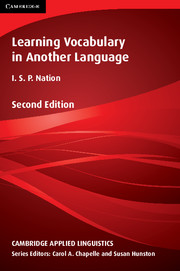Book contents
- Frontmatter
- Contents
- Series editors' preface
- Acknowledgements
- Introduction
- 1 The goals of vocabulary learning
- 2 Knowing a word
- 3 Teaching and explaining vocabulary
- 4 Vocabulary and listening and speaking
- 5 Vocabulary and reading and writing
- 6 Specialised uses of vocabulary
- 7 Vocabulary-learning strategies
- 8 Learning words from context
- 9 Word parts
- 10 Using dictionaries
- 11 Deliberate learning from word cards
- 12 Finding and learning multiword units
- 13 Testing vocabulary knowledge and use
- 14 Designing the vocabulary component of a language course
- Appendices
- Subject index
- Author index
1 - The goals of vocabulary learning
Published online by Cambridge University Press: 15 February 2018
- Frontmatter
- Contents
- Series editors' preface
- Acknowledgements
- Introduction
- 1 The goals of vocabulary learning
- 2 Knowing a word
- 3 Teaching and explaining vocabulary
- 4 Vocabulary and listening and speaking
- 5 Vocabulary and reading and writing
- 6 Specialised uses of vocabulary
- 7 Vocabulary-learning strategies
- 8 Learning words from context
- 9 Word parts
- 10 Using dictionaries
- 11 Deliberate learning from word cards
- 12 Finding and learning multiword units
- 13 Testing vocabulary knowledge and use
- 14 Designing the vocabulary component of a language course
- Appendices
- Subject index
- Author index
Summary
The idea behind this chapter is that it is helpful to use frequency and range of occurrence to distinguish several levels of vocabulary. Distinguishing these levels helps ensure that learners learn vocabulary in the most useful sequence and thus gain the most benefit from the vocabulary they learn. Making the high-frequency / mid-frequency / low-frequency distinction ensures that the teacher deals with vocabulary in the most efficient ways.
Counting words
There are several ways of counting words, that is, deciding what will be counted.
Tokens
One way is simply to count every word form in a spoken or written text and if the same word form occurs more than once, then each occurrence is counted. So, the sentence, It is not easy to say it correctly, would contain eight words, even though two of them are the same word form, it. Words which are counted in this way are called tokens, and sometimes running words. If we try to answer questions like ‘How many words are there on a page or in a line?’, ‘How long is this book?’, ‘How fast can you read?’ or ‘How many words does the average person speak per minute?’, then our unit of counting will be the token.
Types
We can count the words in the sentence It is not easy to say it correctly another way. When we see the same word occur again, we do not count it again. So the sentence of eight tokens consists of seven different words or types.
- Type
- Chapter
- Information
- Learning Vocabulary in Another Language , pp. 9 - 43Publisher: Cambridge University PressPrint publication year: 2013

